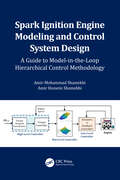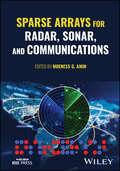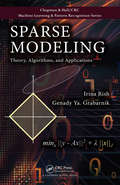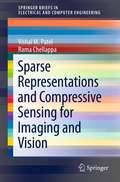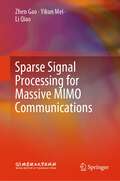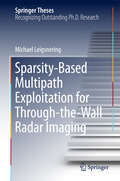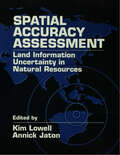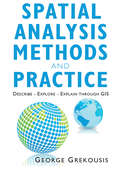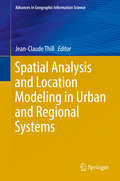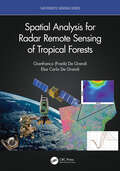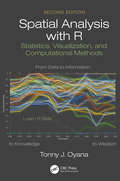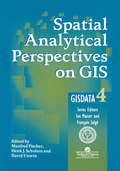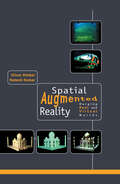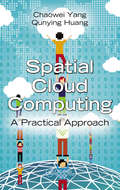- Table View
- List View
Spark Ignition Engine Modeling and Control System Design: A Guide to Model-in-the-Loop Hierarchical Control Methodology
by Amir-Mohammad Shamekhi Amir Hossein ShamekhiThis book presents a step-by-step guide to the engine control system design, providing case studies and a thorough analysis of the modeling process using machine learning, and model predictive control (MPC). Covering advanced processes alongside the theoretical foundation, MPC enables engineers to improve performance in both hybrid and non-hybrid vehicles. Control system improvement is one of the major priorities for engineers seeking to enhance an engine. Often possible on a low budget, substantial improvements can be made by applying cutting-edge methods, such as artificial intelligence when modeling engine control system designs and using MPC. This book presents approaches to control system improvement at mid, low, and high levels of control. Beginning with the model-in-the-loop hierarchical control design of ported fuel injection SI engines, this book focuses on optimal control of both transient and steady state and also discusses hardware-in-the-loop. The chapter on low-level control discusses adaptive MPC and adaptive variable functioning, as well as designing a fuel injection feed-forward controller. At mid-level control, engine calibration maps are discussed, with consideration of constraints such as limits on pollutant emissions. Finally, the high-level control methodology is discussed in detail in relation to transient torque control of SI engines. This comprehensive yet clear guide to control system improvement is an essential read for any engineer working in automotive engineering and engine control system design.
Spark Plasma Sintering of Materials: Advances in Processing and Applications
by Pasquale CavaliereThis book describes spark plasma sintering (SPS) in depth. It addresses fundamentals and material-specific considerations, techniques, and applications across a broad spectrum of materials. The book highlights methods used to consolidate metallic or ceramic particles in very short times. It highlights the production of complex alloys and metal matrix composites with enhanced mechanical and wear properties. Emphasis is placed on the speed of the sintering processes, uniformity in product microstructure and properties, reduced grain growth, the compaction and sintering of materials in one processing step, various materials processing, and high energy efficiency. Current and potential applications in space science and aeronautics, automation, mechanical engineering, and biomedicine are addressed throughout the book.
Sparking a Worldwide Energy Revolution
by Kolya AbramskyAs the earth's carrying capacity continues to be stressed, the question of renewable energies is no longer whether, but when and by whom. Climate change and peak oil have hit the mainstream. Kolya Abramsky's collection maps the world's energy sector and shows how addressing these challenges necessitates an analysis of our economic priorities. Solutions must include massive shifts in our use of technologies and, most importantly, a democratization of the economic landscape based on broad new coalitions.With four distinct sections-Oil Makes the World Go 'Round; From Petrol to Renewable Energies; Struggle Over Choice of Energy Sources and Technologies; and Possible Futures-and over fifty essays from approximately twenty countries, there's nothing like Sparking a Worldwide Energy Revolution to address our global energy crisis.The different chapters bring together a wealth of organizational and analytical experience from across the different branches of the energy sector, both conventional and renewable. Contributors include the following organizations and individuals: China Labour Bulletin (Hong Kong/China), Energy Watch Group (Germany), Focus on the Global South (Thailand), Integrated Sustainable Energy and Ecological Development (India), Public Services International Research Unit (United Kingdom), World Information Service on Energy (Netherlands), Preben Maegaard, and Hermann Scheer.Kolya Abramsky is a former secretariat of the World Wind Energy Institute, based in Denmark, a pioneering country in renewable energy. He is currently a research fellow at the Institute for Advanced Studies on Science, Technology and Society in Austria, and is pursuing a PhD in sociology at State University of New York, Binghamton.
Sparse Arrays for Radar, Sonar, and Communications
by Moeness G. AminSpecialized resource providing detailed coverage of recent advances in theory and applications of sparse arrays Sparse Arrays for Radar, Sonar, and Communications discusses various design approaches of sparse arrays, including those seeking to increase the corresponding one-dimensional and two-dimensional virtual array apertures, as well as others that configure the arrays based on solutions of constrained minimization problems. The latter includes statistical bounds and signal-to-interference and noise ratio; in this respect, the book utilizes the recent strides made in convex optimizations and machine learning for sparse array configurability in both fixed and dynamic environments. Similar ideas are presented for sparse array-waveform design. The book also discusses the role of sparse arrays in improving target detection and resolution in radar, improving channel capacity in massive MIMO, and improving underwater target localization in sonar. It covers different sparse array topologies, and provides various approaches that deliver the optimum and semi-optimum sparse array transceivers. . Edited by a world-leading expert in Radar and Signal Processing and contributed to by world-class researchers in their respective fields, Sparse Arrays for Radar, Sonar, and Communications covers topics including: Utilizing sparse arrays in emerging technologies and showing their offerings in various sensing and communications applications Applying sparse arrays to different environments and obtain superior performances over conventional uniform arrays Solving the localization, beamforming, and direction-finding problems using non-uniform array structures for narrowband and wideband signals Designing sparse array structures for both stationary and moving platforms that produce physical and synthesized array apertures. Using deep neural networks that learn the underlying complex nonlinear model and output the sparse array configuration using representations of the input data spatio-temporal observations Solving for optimum sparse array configurations and beamforming coefficients in sensing using iterative convex optimization methodsProviding complete coverage of the recent considerable progress in sparse array design and configurations, Sparse Arrays for Radar, Sonar, and Communications is an essential resource on the subject for graduate students and engineers pursuing research and applications in the broad areas of active/passive sensing and communications.
Sparse Image and Signal Processing
by Jean-Luc Starck Fionn Murtagh Jalal FadiliThis book presents the state of the art in sparse and multiscale image and signal processing, covering linear multiscale transforms, such as wavelet, ridgelet, or curvelet transforms, and non-linear multiscale transforms based on the median and mathematical morphology operators. Recent concepts of sparsity and morphological diversity are described and exploited for various problems such as denoising, inverse problem regularization, sparse signal decomposition, blind source separation, and compressed sensing. This book weds theory and practice in examining applications in areas such as astronomy, biology, physics, digital media, and forensics. A final chapter explores a paradigm shift in signal processing, showing that previous limits to information sampling and extraction can be overcome in very significant ways. Matlab and IDL code accompany these methods and applications to reproduce the experiments and illustrate the reasoning and methodology of the research are available for download at the associated web site.
Sparse Image and Signal Processing: Wavelets, Curvelets, Morphological Diversity
by Jean-Luc Starck Fionn Murtagh Jalal M. FadiliThis book presents the state of the art in sparse and multiscale image and signal processing, covering linear multiscale transforms, such as wavelet, ridgelet, or curvelet transforms, and non-linear multiscale transforms based on the median and mathematical morphology operators. Recent concepts of sparsity and morphological diversity are described and exploited for various problems such as denoising, inverse problem regularization, sparse signal decomposition, blind source separation, and compressed sensing. This book weds theory and practice in examining applications in areas such as astronomy, biology, physics, digital media, and forensics. A final chapter explores a paradigm shift in signal processing, showing that previous limits to information sampling and extraction can be overcome in very significant ways. Matlab and IDL code accompany these methods and applications to reproduce the experiments and illustrate the reasoning and methodology of the research available for download at the associated Web site.
Sparse Modeling: Theory, Algorithms, and Applications (Chapman & Hall/CRC Machine Learning & Pattern Recognition)
by Irina Rish Genady GrabarnikSparse models are particularly useful in scientific applications, such as biomarker discovery in genetic or neuroimaging data, where the interpretability of a predictive model is essential. Sparsity can also dramatically improve the cost efficiency of signal processing.Sparse Modeling: Theory, Algorithms, and Applications provides an introduction t
Sparse Representation, Modeling and Learning in Visual Recognition
by Hong ChengThis unique text/reference presents a comprehensive review of the state of the art in sparse representations, modeling and learning. The book examines both the theoretical foundations and details of algorithm implementation, highlighting the practical application of compressed sensing research in visual recognition and computer vision. Topics and features: describes sparse recovery approaches, robust and efficient sparse representation, and large-scale visual recognition; covers feature representation and learning, sparsity induced similarity, and sparse representation and learning-based classifiers; discusses low-rank matrix approximation, graphical models in compressed sensing, collaborative representation-based classification, and high-dimensional nonlinear learning; includes appendices outlining additional computer programming resources, and explaining the essential mathematics required to understand the book.
Sparse Representations and Compressive Sensing for Imaging and Vision
by Vishal M. Patel Rama ChellappaCompressed sensing or compressive sensing is a new concept in signal processing where one measures a small number of non-adaptive linear combinations of the signal. These measurements are usually much smaller than the number of samples that define the signal. From these small numbers of measurements, the signal is then reconstructed by non-linear procedure. Compressed sensing has recently emerged as a powerful tool for efficiently processing data in non-traditional ways. In this book, we highlight some of the key mathematical insights underlying sparse representation and compressed sensing and illustrate the role of these theories in classical vision, imaging and biometrics problems.
Sparse Sensing and Sparsity Sensed in Multi-sensor Array Applications
by Xiangrong Wang Xianghua Wang Weitong Zhai Kaiquan CaiThe book focuses on sparse multi-sensor array systems and design approaches. Both principles and engineering practice have been addressed, with more weight placed on algorithm development. This is achieved by providing an in-depth study on sparse sensing for several major multi-sensor array applications such as beam-pattern synthesis, adaptive beamforming, target detection, arrival angle estimation, and dual-functional radar communications. Sparsity sensed in multi-sensor arrays refers to the sparse property of the spatial spectrum sensed. The exploitation of the sparsity in the sensed can significantly enhance the performance of signal processing systems. The comprehensive and systematic treatment of theory and practice in different array applications is one of the major features of the book, which is particularly suited for readers who are interested to learn practical solutions in array signal processing. The book benefits researchers, engineers, and graduate students in the fields of signal processing, electrical engineering, telecommunications, etc.
Sparse Signal Processing for Massive MIMO Communications
by Li Qiao Zhen Gao Yikun MeiThe book focuses on utilizing sparse signal processing techniques in designing massive MIMO communication systems. As the number of antennas has been increasing rapidly for years, extremely high-dimensional channel matrix and massive user access urge for algorithms with much higher efficiency. This book provides in-depth discussions on compressive sensing techniques and simulates the performance on wireless systems. The easy-to-understand instructions with detailed simulations and open-sourced codes provide convenience for readers such as researchers, engineers, and graduate students in the fields of wireless communications.
Sparsity-Based Multipath Exploitation for Through-the-Wall Radar Imaging
by Michael LeigsneringThis thesis reports on sparsity-based multipath exploitation methods for through-the-wall radar imaging. Multipath creates ambiguities in the measurements provoking unwanted ghost targets in the image. This book describes sparse reconstruction methods that are not only suppressing the ghost targets, but using multipath to one’s advantage. With adopting the compressive sensing principle, fewer measurements are required for image reconstruction as compared to conventional techniques. The book describes the development of a comprehensive signal model and some associated reconstruction methods that can deal with many relevant scenarios, such as clutter from building structures, secondary reflections from interior walls, as well as stationary and moving targets, in urban radar imaging. The described methods are evaluated here using simulated as well as measured data from semi-controlled laboratory experiments.
Sparsity-Constrained Linear Dynamical Systems: From Compressed Sensing to Control Theory (Springer Tracts in Electrical and Electronics Engineering)
by Geethu Joseph Chandra R. MurthyThis volume provides a comprehensive overview of recent research advances in the upcoming field of sparse control and state estimation of linear dynamical systems. The contents offer a detailed introduction to the subject by combining classical control theory and compressed sensing. It covers conceptual foundations, including the formulation, theory, and algorithms, and outlines numerous remaining research challenges. Specifically, the book provides a detailed discussion on observability, controllability, and stabilizability under sparsity constraints. It also presents efficient, systematic, and rigorous approaches to estimating the sparse initial states and designing sparse control inputs. It also gives background materials from real analysis and probability theory and includes applications in network control, wireless communication, and image processing. It serves as a compendious source for graduate students and researchers in signal processing and control systems to acquire a thorough understanding of the underlying unified themes. The academic and industrial professionals working on the design and optimization of sparsity-constrained systems also benefit from the exposure to the array of recent works on linear dynamical systems and related mathematical machinery.
Spatial Accuracy Assessment: Land Information Uncertainty in Natural Resources
by Kim Lowell Annick JatonSpatial technologies such as GIS and remote sensing are widely used for environmental and natural resource studies. Spatial Accuracy Assessment provides state-of-the-science methods, techniques and real-world solutions designed to validate spatial data, to meet quality assurance objectives, and to ensure cost-effective project implementation.
Spatial Analysis Methods and Practice: Describe – Explore – Explain through GIS
by George GrekousisThis is an introductory textbook on spatial analysis and spatial statistics through GIS. Each chapter presents methods and metrics, explains how to interpret results, and provides worked examples. Topics include: describing and mapping data through exploratory spatial data analysis; analyzing geographic distributions and point patterns; spatial autocorrelation; spatial clustering; geographically weighted regression and OLS regression; and spatial econometrics. The worked examples link theory to practice through a single real-world case study, with software and illustrated guidance. Exercises are solved twice: first through ArcGIS, and then GeoDa. Through a simple methodological framework the book describes the dataset, explores spatial relations and associations, and builds models. Results are critically interpreted, and the advantages and pitfalls of using various spatial analysis methods are discussed. This is a valuable resource for graduate students and researchers analyzing geospatial data through a spatial analysis lens, including those using GIS in the environmental sciences, geography, and social sciences.
Spatial Analysis Methods of Road Traffic Collisions
by Becky P. Loo Tessa Kate AndersonExamine the Prevalence and Geography of Road CollisionsSpatial Analysis Methods of Road Traffic Collisions centers on the geographical nature of road crashes, and uses spatial methods to provide a greater understanding of the patterns and processes that cause them. Written by internationally known experts in the field of transport geography, the bo
Spatial Analysis and Location Modeling in Urban and Regional Systems
by Jean-Claude ThillThe contributed volume collects cutting-edge research in Geographic Information Science & Technologies, Location Modeling, and Spatial Analysis of Urban and Regional Systems. The contributions emphasize methodological innovations or substantive breakthroughs on many facets of the socio-economic and environmental reality of urban and regional contexts.
Spatial Analysis for Radar Remote Sensing of Tropical Forests (SAR Remote Sensing)
by Gianfranco D. De Grandi Elsa Carla De GrandiSpatial Analysis for Radar Remote Sensing of Tropical Forests is based on the authors’ extensive involvement in Synthetic Aperture Radar (SAR) mapping projects, targeting the health of an earth ecosystem with great relevance for climate change studies: the tropical forests. The subject is developed from a vantage point provided by analysis in a combined space, scale (frequency), time, wavelength, polarization domain. The combination of space and scale offers the capability to zoom in and out like a virtual microscope to the resolution in tune with the underlying ecological phenomenon. It also enables statistical measures (correlations) related to the forest spatial distribution in case of backscatter, or to the canopy height variations in case of interferometric observations. The time dimension brings into play measures of the ecosystem dynamics, such as the flooding extent in the swamp forests, deforestation or degradation events. Wavelength and polarization agility extend the abovementioned capabilities by radar observations that are in tune with particular characteristics of the forest and terrain layers. The book’s spotlight is on radar spatial random fields, these being populated by either backscatter observations or elevation data from interferometric SAR. The basic tenet here is that the spatial statistic of the fields measured by the wavelet variance (in stationary or non-stationary situations) carries fingerprints of the forest structure. Features: Uniquely focused on specific techniques that provide multi-resolution spatial and temporal analysis of forest structure characteristics and changes. Examines several large and important international remote sensing projects aimed at documenting entire tropical ecosystems. Provides novel wavelet methods for tropical forest structural measures. As the first book on this topic, this composite approach appeals to both students learning through important case studies and to researchers finding new ideas for future studies.
Spatial Analysis with R: Statistics, Visualization, and Computational Methods
by Tonny J. OyanaIn the five years since the publication of the first edition of Spatial Analysis: Statistics, Visualization, and Computational Methods, many new developments have taken shape regarding the implementation of new tools and methods for spatial analysis with R. The use and growth of artificial intelligence, machine learning and deep learning algorithms with a spatial perspective, and the interdisciplinary use of spatial analysis are all covered in this second edition along with traditional statistical methods and algorithms to provide a concept-based problem-solving learning approach to mastering practical spatial analysis. Spatial Analysis with R: Statistics, Visualization, and Computational Methods, Second Edition provides a balance between concepts and practicums of spatial statistics with a comprehensive coverage of the most important approaches to understand spatial data, analyze spatial relationships and patterns, and predict spatial processes. New in the Second Edition: Includes new practical exercises and worked-out examples using R Presents a wide range of hands-on spatial analysis worktables and lab exercises All chapters are revised and include new illustrations of different concepts using data from environmental and social sciences Expanded material on spatiotemporal methods, visual analytics methods, data science, and computational methods Explains big data, data management, and data mining This second edition of an established textbook, with new datasets, insights, excellent illustrations, and numerous examples with R, is perfect for senior undergraduate and first-year graduate students in geography and the geosciences.
Spatial Analysis, GIS and Remote Sensing: Applications in the Health Sciences
by Donald P. Albert Wilbert M. Gesler Barbara LevergoodThis new book explores the rapidly expanding applications of spatial analysis, GIS and remote sensing in the health sciences, and medical geography.
Spatial Analytical Perspectives on GIS: Gisdata 4
by Manfred Fischer, Henk J. Scholten and David UnwinThe ability to manipulate spatial data in different forms and to extract additional meaning from them is at the heart of GIS, yet genuine spatial analysis tools are rarely incorporated into commercial software, thus seriously limiting their usefulness. The future of GIS technology wil depend largely on the incorporation of more powerful analytical and modelling functions - and there is agreement within the GIS community of the urgent need to address these issues. This text attempts this task. It presents the latest information on incorporating spatial analysis tools into GIS, and includes concepts and applications from both the environmental and socio-econimc sciences.
Spatial Audio (Music Technology Ser.)
by Francis RumseyExplores the principles and practical considerations of spatial sound recording and reproduction. Particular emphasis is given to the increasing importance of multichannel surround sound and 3D audio, including binaural approaches, without ignoring conventional stereo. The enhancement of spatial quality is arguably the only remaining hurdle to be overcome in pursuit of high quality sound reproduction. The rise of increasingly sophisticated spatial sound systems presents an enormous challenge to audio engineers, many of whom are confused by the possibilities and unfamiliar with standards, formats, track allocations, monitoring configurations and recording techniques. The author provides a comprehensive study of the current state of the art in spatial audio, concentrating on the most widely used approaches and configurations. Anyone wishing to expand their understanding of these cutting-edge technologies will want to own this book.
Spatial Audio Reproduction with Primary Ambient Extraction
by Jianjun HeThis book first introduces the background of spatial audio reproduction, with different types of audio content and for different types of playback systems. A literature study on the classical and emerging Primary Ambient Extraction (PAE) techniques is presented. The emerging techniques aim to improve the extraction performance and also enhance the robustness of PAE approaches in dealing with more complex signals encountered in practice. The in-depth theoretical study helps readers to understand the rationales behind these approaches. Extensive objective and subjective experiments validate the feasibility of applying PAE in spatial audio reproduction systems. These experimental results, together with some representative audio examples and MATLAB codes of the key algorithms, illustrate clearly the differences among various approaches and also help readers gain insights on selecting different approaches for different applications.
Spatial Augmented Reality: Merging Real and Virtual Worlds
by Oliver Bimber Ramesh RaskarLike virtual reality, augmented reality is becoming an emerging platform in new application areas for museums, edutainment, home entertainment, research, industry, and the art communities using novel approaches which have taken augmented reality beyond traditional eye-worn or hand-held displays. In this book, the authors discuss spatial augmented r
Spatial Cloud Computing: A Practical Approach
by Chaowei Yang Qunying HuangAn exploration of the benefits of cloud computing in geoscience research and applications as well as future research directions, Spatial Cloud Computing: A Practical Approach discusses the essential elements of cloud computing and their advantages for geoscience. Using practical examples, it details the geoscience requirements of cloud computing, c
